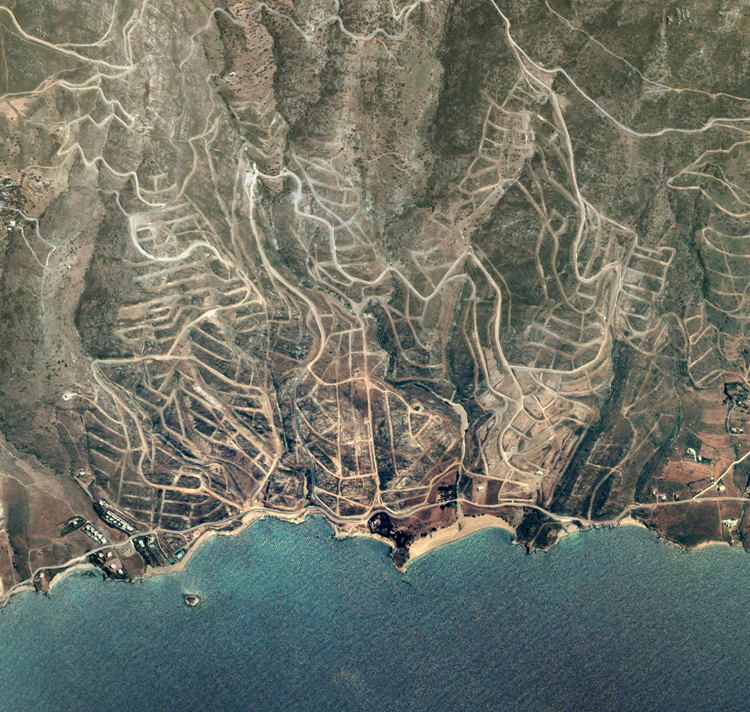
Defaced land: Reading the marks of a social obsession
– Konstantinos Manolidis
Street networks commonly serve some form of human habitation. That’s why the image of a dense pattern of driveways leading to vacant plots in a natural landscape seems absurd. Usually the outcome of a suspended residential development, this image has the uncanny quality of a misplaced fragment.
In many coastal areas of Greece the hillsides are marked with such enigmatic patterns. Large tracts of land ranging from 50 to 500 hectares are lined with road systems of absent or rudimentary settlements. They are the unfinished projects of the numerous construction cooperatives (Oikodomikoi Synetairismoi) operating in the country, that aim to develop large rural properties. The Greek model of a construction cooperative is a privately financed planning method, initially established to answer housing needs through low-cost suburban developments. Eventually though, they committed themselves to satisfying an obsessive demand for second homes in the countryside.
The zeal in occupying and disfiguring land, embedded so emphatically in these extensive scars, does not represent just the climax the domestic real estate market reached. It is also an expression of deeper disorders somehow linked to the calamities and disruptions that occurred in 20th century Greece.
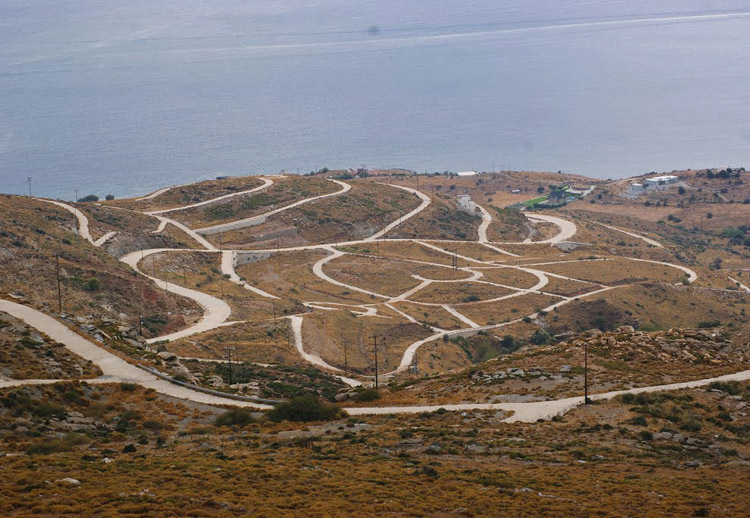
Image 1. Road network at Karystos, Evoia. Source: http://www.panoramio.com
Appetite for building
As in many other countries, rising income and social prosperity have resulted in a significant increase in the demand for second homes, especially in scenic rural areas. However, in Greece, during the last 3 decades of the last century, the number of recreational countryside houses multiplied out of control, resulting in serious aesthetic degradation of the landscape. The rate at which the coastline, as well as parts of the country’s inland, has been taken over by scattered residential development is overwhelming. Houses, villas and small apartment complexes, often violating regulations or simply illegal, have spread like a new disease1.
This phenomenon is quite distinct from the developmental practices that disfigured, for example, the Spanish coasts. In the case of the Greek second home business, the target group is not the European clientele of middle-class retirees but the domestic market. Furthermore, the percentage of large developments is still quite small, with the privately funded and erected single villa being the dominant model2.

Image 2. Unfinished development at Mpouros, Evoia. Source: Google Earth
In order to grasp this persistent widespread demand for holiday homes we must understand how a developmental mentality has saturated the collective conscience. In post war Greece, the construction industry has been the main activity boosting economic growth, fighting unemployment and securing a social consensus3. In some manner, everybody was likely to benefit from it. During an intensive urbanization period many people traded their small building plots on a “flats for land” basis, and others turned into occasional small scale contractors and developers, mostly to exploit their own property4. With the consent of loose housing policies, a type of informal and sometimes unconstrained small building business thrived along with the more structured and orderly construction firms. Thus, building construction and land speculation functioned within a favorable social momentum and from technical and financial undertakings assumed the character of a social practice5.
A product of this broader trend are the more than 200 construction cooperatives operating in Greece, that own or claim rights to approximately 22,000 hectares of land6. Economic degradation and depopulation of the Greek periphery allowed groups of potential second-home owners, usually members of the same professional unions, to acquire large pieces of cheap forest or pasture land. Providing a view to the sea and proximity to Athens or major urban areas, the irresistible Mediterranean scenery of the property would attract hundreds of shareholders. Each of them contributed to the cost of the infrastructure and was solely responsible for building their own house, usually a single-family dwelling.
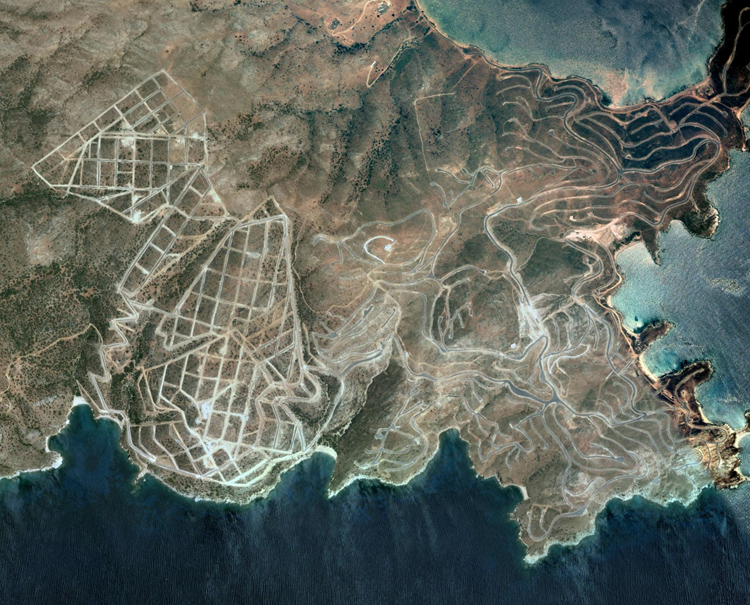
Image 3. Unfinished development at Erodios, Evoia. Source: Google Earth
The parcels of land that building cooperatives had purchased were usually of a controversial status as they were listed as “forested land” even if they weren’t heavily wooded. In Greek legislation the term “forested land” applies also to bush covered areas that can be reforested and in any case must remain intact. As no reliable national land registry exists, unsettled disputes over the property rights or the forestry listing of a rural plot are common.
Many of these enterprises faced serious legal obstructions and were never entitled to a building permit as their land was lying in former forest areas designated for reforestation. Regardless of such obstacles, many cooperatives, exploiting legal tricks, proceeded to realise the basic elements of the planned development, consisting more or less of a street network. It was a risky but necessary step in order to exert pressure on politicians. A seemingly finished infrastructure helps to attract more members, which in turn also act as pressure group for a positive resolution with the state7.
Highly speculative practices of this kind resulted in large numbers of planned areas in various degrees of abandonment. Some of them are maintained aspiring to a future building permit, others are already scattered with houses and few are left to the weeds. In any case, their large scale, insensitive layout and hasty construction seriously disrupt the landscape’s coherence and visual integrity.
Landscape scars
The full range of the resulting scars in the undulating landscape is not always comprehensible from the ground. Nowadays though, it’s easy to capture it through the free satellite imaging portals. The aerial perspective reveals these road systems unfolding like huge geoglyphs in the slopes of the Greek countryside.
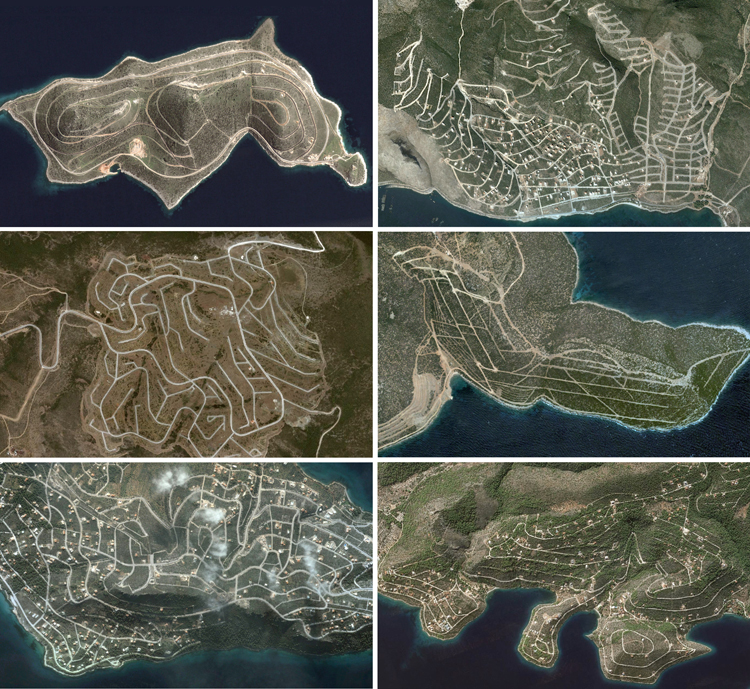
Image 4. Second home developments in Greece. Source: Google Earth
The conversion of the rural areas into a post-productive state consumed for leisure housing raises serious questions about the limits in the appropriation of landscape resources. Large areas have aborted their agrarian uses and are covered by infrastructure and sprawling low-density housing that serves no particular accommodation need and is inherently unsustainable. Furthermore, serious environmental issues arise, like clearance of vegetation, wildlife disruption and pollution due to sewage and rubbish disposal8.
At the same time this kind of development generates substantial changes in the biophysical state of the land surface. In many cases the developments are planned with indifference to the landscape’s relief and the existing environmental regulations are never strictly applied or enforced. Slopes are ruptured and excavation materials are let flow downhill, producing sores visible for miles. Such alterations can contribute to soil destabilization and erosion, by removing woody vegetation and redirecting storm runoff into portions of the landscape not prepared to receive such flows9.
However, what seems really intriguing here are the cultural and symbolic aspects of these spatial practices. The landscapes of modern Greece are marred by manifold activities and misbehaviours that indicate not only a confused collective psyche but also a kind of hostility unconsciously directed at the face of the earth. A profound ambivalence makes possible the coexistence of an idealized perception and adoration of natural scenery with an impulse to deface the very object of this desire.
Is this attitude a residue of a primeval urge to mark someone’s territory by dirtying it? French philosopher Michel Serres has referred to an “excremental origin of property rights” that seems to be “a cultural source of what we call pollution, which, far from being an accidental result of involuntary acts, reveals deep intentions and a primary motivation”10. So, the road patterns defacing the landscape could also be comprehended as an aggressive assertion of property rights, the marks of the land’s dominators.
However, dealing with the land wasn’t always like this. Living in the countryside required a constant and elaborated process of modification and maintenance of the ground. For instance, inhabitants of the hilly and arid areas of Greece had to build dry stonewalls to stabilize the soil and thus afford strips of arable land on the steep terrain. Likewise, vernacular countryside architecture of the recent past was displaying a strong articulation of topography’s intrinsic qualities. Architecture and ground were intertwined in a symbiotic interaction, full with a potential for reconciliation with nature’s multiplicities11.
It seems inexplicable, how in the course of two generations this relationship faded so much. Affection towards the land gave way to an almost terminal indifference. The inventive as well as careful response to the difficult terrain turned into a disrespectful and unsympathetic comprehension of the ground, solely as a building site. Land is faced as a neutralized commodity and thereby assumes no particularity, no character and no intrinsic values12. In this manner, the construction companies direct planners and designers take control of the sites by imposing dense road networks and rigid plot subdivisions, thus erasing the diversity and qualities of the landscape. In spite of the fascination with natural vistas and the marketable Mediterranean idyll, no resonance with the integrity of the natural setting is taking place anymore.
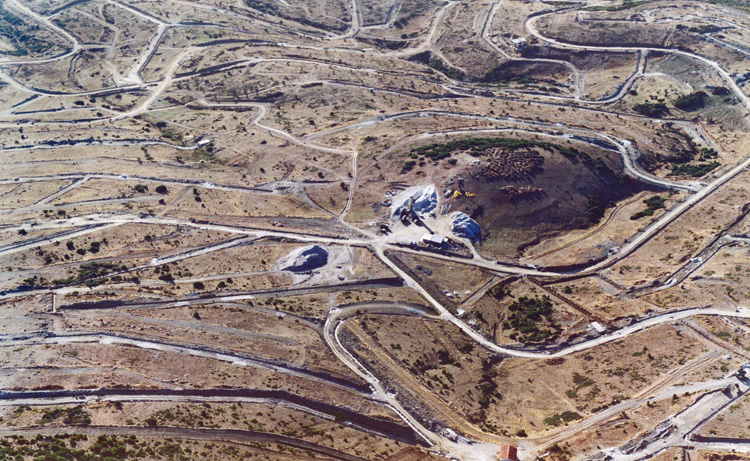
Image 5. Road network at Kissos, Thessaloniki. Source: https://www.karfitsa.gr
A land of traumas
Maybe it is not an overstatement to say that, in contemporary Greece, erecting buildings has become the principal mode of dealing with the reality of the countryside. But, is this tendency only an expression of greed, domination or laundering untaxed money? Undoubtedly, the countryside home craze evolved from a more complex background, shaped by the underlying disorders caused by Greece’s rapid transition during the 20th century. The cultural dissolution inflicted by this process radically affected economic and social systems, living habits and belief structures. The adaptation period for such a cultural shift was extremely brief, restricting the potential for reorganization of the social fabric.
If Greece’s late and hasty modernization was already problematic, certain circumstances played their part in the further deterioration of the situation. In the middle decades of the 20th century a violent demographic transition took place in the country. The economic crisis of the thirties and the successive German occupation pushed inhabitants of the Greek periphery to extreme poverty and to involuntary emigration13. The end of World War II left Greece’s inland in ruins. The already poor public and residential infrastructure was seriously damaged and the successive civil war obstructed the necessary reconstruction. In addition, many areas of the mountainous periphery were forcefully evacuated by the National Army during civil war operations14. Consequently, almost half of the population of the countryside moved permanently to the cities in order to make a living. A whole web of, still active, social dysfunctions emerged from such a rearrangement15.
For instance, the perception of nature was not simply reshaped but largely distorted. An intense emotional alienation from the countryside was developed by the multiple frustrations related with the above-mentioned events. The land that had to be abandoned was a let down, like a parental figure unable to shelter and sustain thier children. The collective understanding of nature, as a vital and common resource, disintegrated, making room only for utilitarian considerations and atavistic territorial instincts.
On the psychological level, the severe individual scars merged into a collective memory that identified the countryside with constant hardship or devastating disasters. A kind of cultural trauma never recognized and addressed was charging the countryside with an unconscious negativity16. This latent negativity was activated in the 1970s and ’80s when economic improvement allowed a mass reengagement with the countryside through tourism and summer holidays. The new contact escalated in the obsessive efforts to possess land, discipline it with road networks and excessively build on it. A double purpose was thus satisfied. On the one hand, an overcompensation mechanism was operating to overcome the defect caused by the housing shortage experienced in previous decades. Indulgence in construction somehow was exorcising the past ruination of villages. On the other hand, it seems that the construction rush was also a subliminal retaliation, a return of wounds to the countryside, the locus inextricably linked with the rise of manifold traumas17.
The above explanation shouldn’t be mistaken as an effort to excuse the aberrations of Greek society by stressing its past victimization. What is suggested here is that the sources of abuses expressed toward the landscape have roots deeper than we tend to believe. Many puzzling behaviors and spatial practices cannot be understood without examining the social and psychological dynamics set in motion in turbulent post-war Greece.
Unfortunately, land is always a convenient arena where contradicting desires, repressed traumas and social pathologies can evolve, take shape and leave their unpleasant marks.
Notes
1. Beriatos, E. (2008). Uncontrolled Urbanization, Tourism Development and Landscape Transformation in Greece. In: 44th ISOCARP Congress 2008.
2. Minetos, D., Polyzos, S., Sdrolias, L. (2007). Features and Spatial Analysis of Illegal Housing in Greece. Management of International Business & Economic Systems, Vol 1, (1), pp. 86-107.
3. Lampropoulou, D. (2009). Builders. The men that built Athens, 1950-1967. Athens: Vivliorama, (in Greek).
4. Tsoulouvis, L. (1996). Urban planning, social policy and new forms of urban inequality and social exclusion in Greek cities. International Journal of Urban and Regional Research, 20, pp. 718-732.
5. Lampropoulou, D. (2009). Builders.
6. Mpitsika, P. (2007). The war of the building sites: 22,000 hectares of forest land are claimed by the Cooperatives. To Vima (in Greek).
7. Ibid.
8. See: Beriatos, E. (2008). Uncontrolled Urbanization; and Beriatos, E. (2012). Greek landscape: problems, policies, perspectives. In: Papayannis, Th., Howard, P. (eds), Reclaiming the Greek landscape. Athens: Med-INA.
9. Papayannis, Th., Howard, P. (2012). Introduction. In: Papayannis Th., Howard P. (eds), Reclaiming the Greek landscape. Athens: Med-INA.
10. Serres, M. (1995). The Natural Contract. Ann Arbor: University of Michigan Press, p. 33.
11. Dripps, R. (2005). Groundwork. In: Burns, C., Kahn, A. (eds), Site Matters. Design concepts, histories and strategies. New York: Routledge.
12. Ibid.
13. Kotzamanis, B. (1990). Rural population mobility in 1940-50 decade and the restructuring of social-demographic map of postwar Greece. Journal of social research, 77, pp. 97-126 (in Greek).
14. Margaritis, G. (2001). History of Greek Civil War 1946-49, Vol 2. Athens: Vivliorama, (in Greek).
15. Demertzis, N. (2011). Greek civil war as cultural trauma. Science and Society, 28, pp. 81-109 (in Greek).
16. Manolidis, K. (2009). The countryside and the traumas of postwar Greece. In: Kanarelis, Th., Manolidis, K. (eds), The claim of the outdoors. Nature and social practices in modern Greece. Athens: Indictos and University of Thessaly, (in Greek).
17. Ibid.
Konstantinos Manolidis is a professor in the Department of Architecture, University of Thessaly, Greece. He graduated from the Aristotle University of Thessaloniki and received the M.Arch degree from Southern California Institute of Architecture (SCI-Arc). Manolidis has worked extensively in public architectural design projects. His research focuses on the landscapes of the Greek periphery, public space and the materiality of architecture. He is the author of Edafologio: Texts on the Materials of Architecture and has edited the books Beautiful, Awful and Austere Landscape: Readings and Perspectives on the Landscape in Greece, Representation as a Vehicle of Architectural Thought, and The Claim of the Outdoors and Transformations of Space and its Meaning in Greece amid Crisis (all in Greek).
Volume 3, no. 3 Autumn 2020
